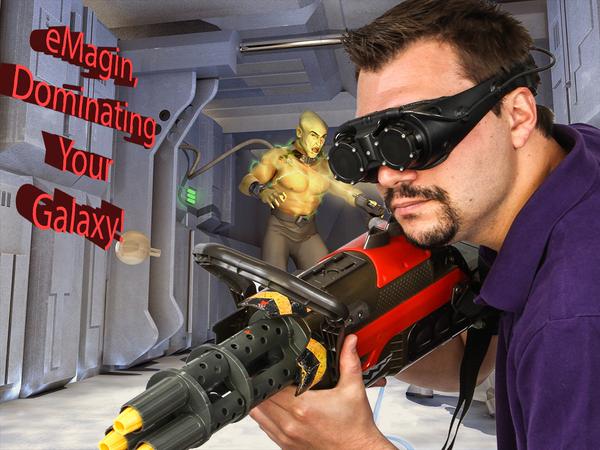Margaret Kohin, SVP, Business Development, eMagin Corporation was invited to present a Special Wearables Address at the Wearable-Flexible Market Focus Conference organized by IHS at SID’s 2015 Display Week. Kohin’s address was unique at the SID Wearables Conference in that it was the only presentation to address head mounted displays (HMDs) and applications to products like eyeglass displays.
After the recent Google Glass experiment, eyeglass display applications are viewed by some as a category with diminished chances of market adoption. While virtual reality (VR) applications of HMDs epitomized by Oculus Rift appear to be proceeding apace, augmented reality (AR) product adoption appears to have largely stalled, if Google Glass is indicative. As the photo below from a recent eMagin announcement illustrates, while Glass opted for fashion sense, eMagin is emphasizing its defense industry background and display performance (I think).
 Source: eMagin
Source: eMagin
In her address, Kohin stated that eMagin has launched a new HMD business for consumer applications and markets. This thrust was previously revealed in late 2014 but her SID presentation provided a comprehensive update on progress toward that goal. The title of her presentation, Bridging the Gap from Head-Mounted Display for Avionics and Defense to Consumer Products, was an apt description of eMagin’s efforts to transition its defense technology development of AMOLED image arrays to the consumer electronics market.
The current state of development of the company’s technology encompasses a 4 Mpixel AMOLED microdisplay capable of 6500 cd/m² operation that yields an immersive 90 degree field of view (FOV). Kohin pointed out that eMagin is the leading producer of AMOLED microdisplays and in 2006 launched the Z-800 HMD which won a CES Innovations Award in 2006 for Best New Display and Best New Gaming Device for 2006. It seems that nine years later eMagin is still looking to capitalize on a consumer HMD market, as and when it develops.
Kohin stated that all defense and soldier HMDs are moving to OLED including night vision goggles, thermal rifle sights and the Javelin missile targeting system. Upcoming defense equipment adoption includes avionics helmets for pilots – an AR application demanding display brightness >10,000 cd/m² with a development goal of 20,000-30,000 cd/m² for daylight use. Ms. Kohin also pointed out that in night vison applications, high display contrast is very important as it reduces the “green glow” resulting from lack of display contrast in LCD applications. She also noted that soldiers likewise need high display contrast to see into shadows in daytime.
Kohin went on to review the application of microdisplays to AR, mixed reality and VR markets and applications. AR displays require the highest brightness, and the need for very compact optics may result in low optics transmission thus requiring high brightness displays in the 20,000–30,000 cd/m² range. She noted that VR requires the highest frame rate with (essentially) no image latency or smear. She mentioned that high brightness is also needed for VR so as to achieve a low smear/low latency solution since a solution for this problem is to use high peak brightness along with short frame duration.
Emagin currently offers AMOLED microdisplays with 8-15 um pixels, 300K to 4 Mpixels in sizes ranging from 0.47 to 0.89 inches. The key advantages of eMagin’s AMOLED image arrays are their low power consumption, no need for a backlight, heater or additional driver chip, small form factor, no image smear, and highest contrast. These key characteristics are of course enabled by the use of OLED display technology rather than LCD. eMagin’s investment in development of AMOLED microdisplays (in part with US government defense funding) may position the firm as a key supplier in a possible future market for consumer electronics wearable device displays. – Phil Wright

